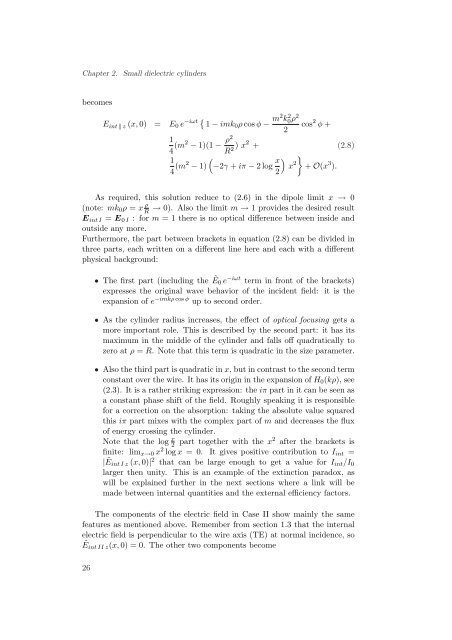Optical properties of cylindrical nanowires
Optical properties of cylindrical nanowires
Optical properties of cylindrical nanowires
You also want an ePaper? Increase the reach of your titles
YUMPU automatically turns print PDFs into web optimized ePapers that Google loves.
Chapter 2.Small dielectric cylindersbecomesE int ‖ z (x, 0) = E 0 e −iωt { 1 − imk 0 ρ cos φ − m2 k0 2ρ2cos 2 φ +214 (m2 − 1)(1 − ρ2R 2 ) x2 + (2.8)1(4 (m2 − 1) −2γ + iπ − 2 log x ) }x 2 + O(x 3 ).2As required, this solution reduce to (2.6) in the dipole limit x → 0(note: mk 0 ρ = x ρ R→ 0). Also the limit m → 1 provides the desired resultE int I = E 0 I : for m = 1 there is no optical difference between inside andoutside any more.Furthermore, the part between brackets in equation (2.8) can be divided inthree parts, each written on a different line here and each with a differentphysical background:• The first part (including the Ẽ0 e −iωt term in front <strong>of</strong> the brackets)expresses the original wave behavior <strong>of</strong> the incident field: it is theexpansion <strong>of</strong> e −imkρ cos φ up to second order.• As the cylinder radius increases, the effect <strong>of</strong> optical focusing gets amore important role. This is described by the second part: it has itsmaximum in the middle <strong>of</strong> the cylinder and falls <strong>of</strong>f quadratically tozero at ρ = R. Note that this term is quadratic in the size parameter.• Also the third part is quadratic in x, but in contrast to the second termconstant over the wire. It has its origin in the expansion <strong>of</strong> H 0 (kρ), see(2.3). It is a rather striking expression: the iπ part in it can be seen asa constant phase shift <strong>of</strong> the field. Roughly speaking it is responsiblefor a correction on the absorption: taking the absolute value squaredthis iπ part mixes with the complex part <strong>of</strong> m and decreases the flux<strong>of</strong> energy crossing the cylinder.Note that the log x 2part together with the x2 after the brackets isfinite: lim x→0 x 2 log x = 0. It gives positive contribution to I int =|Ẽint I z (x, 0)| 2 that can be large enough to get a value for I int /I 0larger then unity. This is an example <strong>of</strong> the extinction paradox, aswill be explained further in the next sections where a link will bemade between internal quantities and the external efficiency factors.The components <strong>of</strong> the electric field in Case II show mainly the samefeatures as mentioned above. Remember from section 1.3 that the internalelectric field is perpendicular to the wire axis (TE) at normal incidence, soẼ int II z (x, 0) = 0. The other two components become26
















